Contents
Mikado Black tomato is a variety that has been cultivated by vegetable growers for several decades. The variety is considered quite common. It is grown both in the regions of Our Country and in other countries. In particular, the variety was loved for its taste and peculiar appearance.
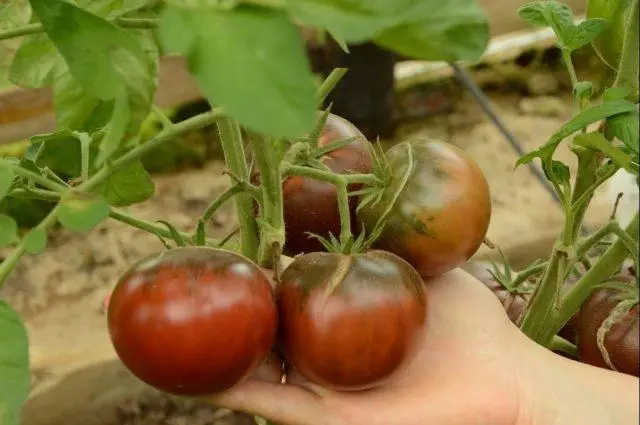
The chocolate color of the fruit is atypical for the culture.
History of breeding
The variety is not new, it appeared a long time ago. Little is known about its history. Presumably, Mikado black was created by an amateur breeder.
Description of black Mikado tomato
This type of culture belongs to the indeterminate standard type. Its bushes are tall, their height can reach two meters when grown in greenhouse conditions and is about 170 cm when cultivated in open areas.
The stems of the plant are healthy, strong, thick, but quite flexible. Leaf plates cover the bush in moderation and have a distinctive feature in that they are very similar to potato leaves. Their color is expressive, dark emerald, the size is large.
Mikado black fruits are large, flat-round in shape, up to five pieces are formed on one brush. Their average weight is 200-350 g, but some specimens can reach a mass of 0,5 kg. The color of the vegetable has a brown tint or chocolate. The taste is sugary, with pronounced sweetness and fruity notes.
The more sun the bush gets, the tastier the tomatoes will be. The pulp inside the fruit is quite juicy, not watery, dense and fleshy, with a pleasant tomato flavor, dark red color. Seed chambers are medium-sized, in the amount of about seven pieces.
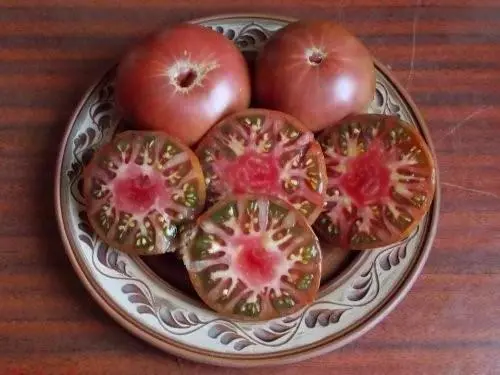
Mikado black is suitable for growing both outdoors and indoors.
Characteristics of Mikado black tomato
The Black Mikado is considered a mid-early variety of tomato that usually ripens, depending on weather conditions, about three months after sowing. The ovaries on the bushes are formed together and quickly. The collection period is stretched from July to early autumn.
Since the immunity of the variety is quite strong, the bushes safely endure natural disasters, but develop and grow best in sunny and warm weather. In a mature form, tomatoes do not lie for long, no more than five days. Growing varieties on an industrial scale is not practiced due to the loss of commercial qualities during transportation.
Yield of black Mikado tomato
The maximum yield of black Mikado tomato is observed when grown in the Rostov and Astrakhan regions, on the Crimean peninsula and in the regions of the Krasnodar Territory.
If the gardener follows all the agrotechnical rules for growing Mikado black, then the harvest will be good. From one square meter of the plot, you can collect up to 15 kg of fruit.
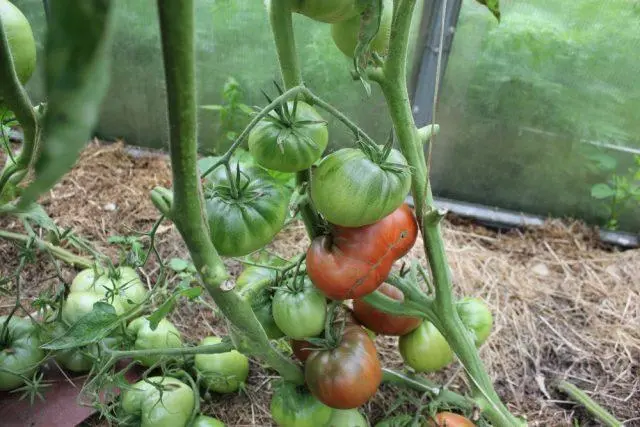
On average, a variety bush produces about 5 kg of tomatoes.
Disease and pest resistance
The resistance of the variety to diseases and insect attacks is considered quite high. Most of all, the bushes are susceptible to the brown spot disease, and small white butterflies (whiteflies) can attack the Mikado black tomato from insects.
Methods of Use
In particular, black Mikado tomato is consumed fresh. The main purpose of the fruit is to add it to salads. Due to the fact that the vegetable is large in size, and its skin is tender and thin, it is unsuitable for conservation. An exception can only be the manufacture of juice, tomato or ketchup from fruits.
Advantages and disadvantages of Mikado black tomato
The variety has a peculiar color, which is why it is considered an amateur tomato. It has a long list of advantages, but it also has disadvantages.
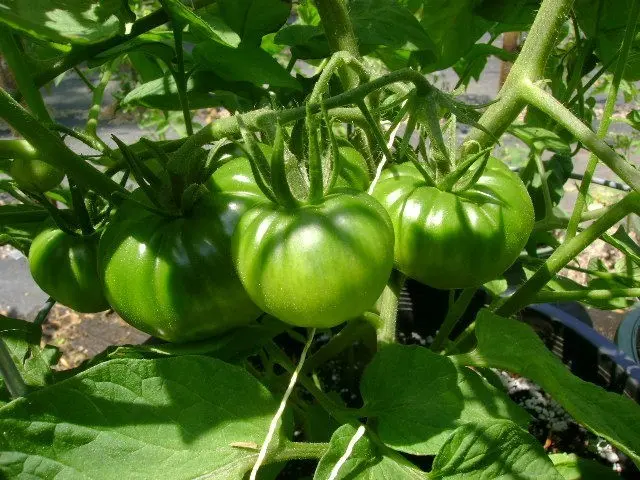
Mikado black changes taste after heat treatment
Advantages:
- large fruits;
- strong immune system;
- keeping quality in unripe form;
- resistance to adverse weather conditions.
Disadvantages:
- the need for shaping and garter;
- unsuitability of transportation;
- cracking of fruits during untimely harvesting;
- unsuitable for whole preservation.
Features of planting and care
Mikado black tomato seeds begin to be sown two months before the intended planting in the ground. Usually this is the end of February or the first half of March. In the case of cultivation in northern latitudes, sowing of planting material is allowed until the second half of April.
Sowing should be carried out in a container with holes, to a depth of 1 cm, with an interval of 1-2 cm from each other, in moistened soil. Next, the container must be covered with a film and placed on a windowsill in a warm room, after the emergence of seedlings, remove the shelter. Ten days before transplanting seedlings to a permanent place, it should begin to harden.
After the formation of flower brushes on tomatoes, they should be planted in beds. To do this, choose a fertile and well-lit area with slightly acidic soil, preferably if carrots or onions grew there. Bushes are planted at a distance of 0,5 m from each other, in cloudy weather. After carrying out the work, the beds are watered and covered with covering material. This is done so that the plant adapts faster.
As for care, until the seedlings of the Mikado black tomato take root, they organize regular watering as the earth dries up. Further moisturizing is carried out a couple of times a week. Periodically, the beds are loosened, weeded and mulched. Bushes must be tied to supports, formed into three stems. Stepchildren on this variety are removed at least twice a month. In addition, Mikado black needs frequent feeding. Every two weeks, the bushes are fertilized with either organic or mineral compounds.
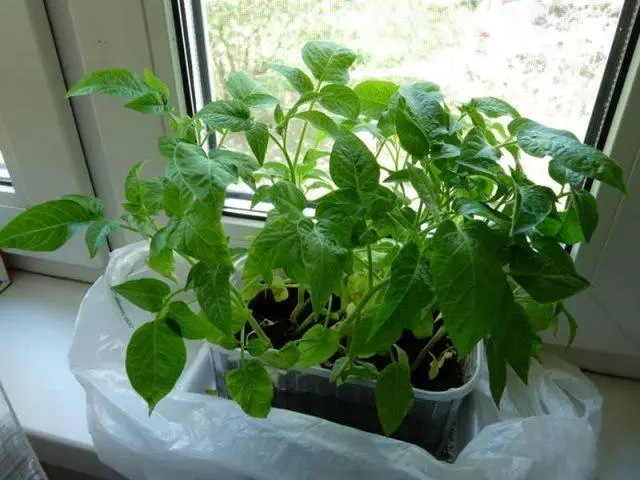
It is impossible that the predecessor of Mikado black was potatoes
Pest and disease control
The variety has a fairly strong immunity. Very rarely affected by Fusarium, resists the nematode. The main disease that Mikado black is more susceptible to is brown spotting. The disease can be identified by spots that appear first on the lower shoots, and then spread to the entire bush. The sooner signs of damage are detected and appropriate treatment with Antracol or Consento is started, the more likely it will be to save the crop.
As for harmful insects, the black Mikado can attract the attention of the whitefly. Spraying the bushes with a solution of Confidor helps to bring it out (1 tablespoon per bucket of water).
Conclusion
Mikado black tomato is a heat-loving variety of unusually colored tomatoes. The fruits are large and tasty, grow well even in the northern regions, but under cover. The variety is quite demanding for care, it needs to tie the bushes to the trellis, as well as pinching. Since the tomato is natural, you can collect seeds from it and use them to plant seedlings for the next year.









